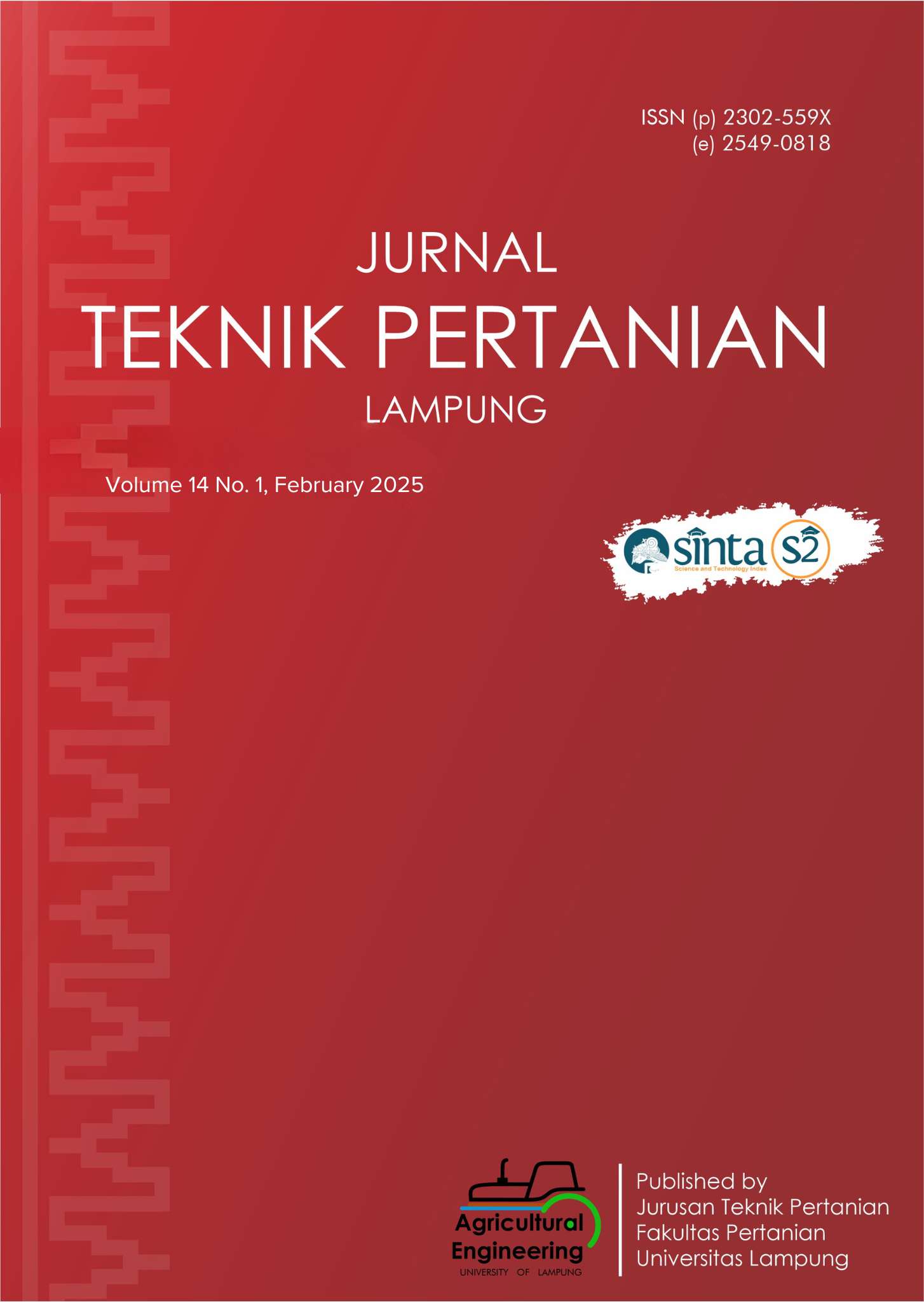Improving Mechanical Properties of Biofoam Using Oil Palm Fiber as Filler at Various Temperatures and Processing Times
DOI:
https://doi.org/10.23960/jtep-l.v14i1.130-136 Abstract View: 286
Abstract View: 286
Abstract
Biofoam, as an alternative packaging material based on tapioca starch, has become a choice for environmentally friendly packaging. However, biofoam has a drawback in terms of weak mechanical properties. The use of oil palm fiber, a by-product of CPO production, has gained interest as a material that can improve the mechanical properties of biofoam. This study aims to produce biofoam with the best mechanical characteristics as packaging material through variations in temperature and processing time. The production of biofoam was carried out using the thermopressing method on tray-shaped molds with variations in molding temperature of 180°C, 190°C, and 200°C for 180 seconds and 210 seconds. The dough formulation consisted of 80% starch, 20% fiber, with the addition of 25 grams of water. Mechanical property testing was conducted through tests for moisture content, water adsorption, biodegradability, compressive strength, and tensile strength. The variation of 190°C temperature and 210 seconds baking time resulted in biofoam with the best mechanical properties. This biofoam showed the highest compressive strength value of 26.94 kPa, tensile strength test of 83.11 kPa, the second-highest biodegradability with a percentage of 78.93%, and the second-lowest moisture content with a value of 7.56%. These results indicate that biofoam at a molding temperature of 190°C and a baking time of 210 seconds has the best mechanical properties, making it superior as an environmentally friendly alternative packaging material compared to other formulations.
Keywords: Biofoam, Oil palm fiber, Temperature, Thermopressing.
Downloads
References
Bakar, N. F. A., Rahman, N. A., Mahadi, M. B., Zuki, S. A. M., Amin, K. N. M., Wahab, M. Z., & Lenggoro, I. W. (2021). Nanocellulose from oil palm mesocarp fiber using hydrothermal treatment with low concentration of oxalic acid. Materials Today: Proceedings, 48, 1899–1904. https://doi.org/10.1016/j.matpr.2021.09.357
Bruscato, C., Malvessi, E., Brandalise, R. N., & Camassola, M. (2019). High performance of macrofungi in the production of mycelium-based biofoams using sawdust — Sustainable technology for waste reduction. Journal of Cleaner Production, 234, 225–232. https://doi.org/10.1016/J.JCLEPRO.2019.06.150
da Silva, F. T., de Oliveira, J. P., Fonseca, L. M., Bruni, G. P., da Rosa Zavareze, E., & Dias, A. R. G. (2020). Physically cross-linked aerogels based on germinated and non-germinated wheat starch and PEO for application as water absorbers for food packaging. International Journal of Biological Macromolecules, 155, 6–13. https://doi.org/10.1016/j.ijbiomac.2020.03.123
Engel, J. B., Ambrosi, A., & Tessaro, I. C. (2019). Development of biodegradable starch-based foams incorporated with grape stalks for food packaging. Carbohydrate Polymers, 225(May), 115234. https://doi.org/10.1016/j.carbpol.2019.115234
Hutagalung, S., Sibarani, J., Pramesti, R. Y., & Puspaningtya, T. H. R. (2024). Modifikasi Biofoam Berbasis Pati Singkong dengan Serat Eceng Gondok dan Variasi Konsentrasi Plasticizer. KOVALEN: Jurnal Riset Kimia, 10(2), 114–125. https://doi.org/10.22487/kovalen.2024.v10.i2.17104
Kahvand, F., & Fasihi, M. (2020). Microstructure and physical properties of thermoplastic corn starch foams as influenced by polyvinyl alcohol and plasticizer contents. International Journal of Biological Macromolecules, 157, 359–367. https://doi.org/10.1016/j.ijbiomac.2020.04.222
Kaisangsri, N., Kowalski, R. J., Kerdchoechuen, O., Laohakunjit, N., & Ganjyal, G. M. (2019). Cellulose fiber enhances the physical characteristics of extruded biodegradable cassava starch foams. Industrial Crops and Products, 142(September), 111810. https://doi.org/10.1016/j.indcrop.2019.111810
Kremensas, A., Vaitkus, S., Vėjelis, S., Członka, S., & Kairytė, A. (2021). Hemp shivs and corn-starch-based biocomposite boards for furniture industry: Improvement of water resistance and reaction to fire. Industrial Crops and Products, 166(April), 1–11. https://doi.org/10.1016/j.indcrop.2021.113477
Linda, H., Ariza, Di., & Rahmi, A. (2021). Pembuatan Biofoam Berbahan Dasar Ampas Tebu dan Whey. Jurnal Kimia Dan Kemasan, 43(2), 75–81.
Lubis, N. rizqi F., Dewi, R., Sulhatun, S., Ginting, Z., & Muhammad, M. (2022). Biofoam Berbahan Pati Sagu Dengan Penguat Selulosa Tandan Kosong Kelapa Sawit Sebagai Kemasan Makanan Dengan Metode Thermopressing. Chemical Engineering Journal Storage (CEJS), 2(3), 95. https://doi.org/10.29103/cejs.v2i3.6419
Machado, C. M., Benelli, P., & Tessaro, I. C. (2020). Study of interactions between cassava starch and peanut skin on biodegradable foams. International Journal of Biological Macromolecules, 147, 1343–1353. https://doi.org/10.1016/j.ijbiomac.2019.10.098
Mahmud, M. A., Belal, S. A., & Gafur, M. A. (2023). Development of a biocomposite material using sugarcane bagasse and modified starch for packaging purposes. Journal of Materials Research and Technology, 24, 1856–1874. https://doi.org/10.1016/j.jmrt.2023.03.083
Mejouyo, P., Tiaya, E. M., Sikame Tagne, N. R., Tiwa, S. T., & Njeugna, E. (2022). Experimental study of water-sorption and desorption of several varieties of oil palm mesocarp fibers. Results in Materials, 14(May). https://doi.org/10.1016/j.rinma.2022.100284
Muharram, F. I. (2020). Penambahan Kitosan Pada Biofoam Berbahan Dasar Pati. Edufortech, 5(2). https://doi.org/10.17509/edufortech.v5i2.28814
Muspira, N., Fachraniah, F., & Syaifruddin, S. (2024). Pembuatan Biofoam dari Pati Singkong Dengan Tambahan Serat Selulosa dari Jerami Padi Sebagai Filler. Jurnal Teknologi, 24(1), 67–74.
Nugroho, A., Maharani, D. M., Legowo, A. C., Hadi, S., & Purba, F. (2022). Enhanced mechanical and physical properties of starch foam from the combination of water hyacinth fiber (Eichhornia crassipes) and polyvinyl alcohol. Industrial Crops and Products, 183(November 2021). https://doi.org/10.1016/j.indcrop.2022.114936
Pereira, P. H. F., Souza, N. F., Ornaghi, H. L., & de Freitas, M. R. (2020). Comparative analysis of different chlorine-free extraction on oil palm mesocarp fiber. Industrial Crops and Products, 150(March). https://doi.org/10.1016/j.indcrop.2020.112305
Sihombing, Y. A., Sinaga, M. Z. E., Hardiyanti, R., Susilawati, Saragi, I. R., & Rangga. (2022). Preparation, characterization, and desalination study of polystyrene membrane integrated with zeolite using the electrospinning method. Heliyon, 8(8), 4–9. https://doi.org/10.1016/j.heliyon.2022.e10113
Tacha, S., Somord, K., Rattanawongkun, P., Intatha, U., Tawichai, N., & Soykeabkaew, N. (2022). Bio-nanocomposite foams of starch reinforced with bacterial nanocellulose fibers. Materials Today: Proceedings, 75, 119–123. https://doi.org/10.1016/j.matpr.2022.12.049
Downloads
Published
How to Cite
Issue
Section
License
Authors who publish with this journal agree to the following terms:
Authors retain copyright and grant the journal right of first publication with the work simultaneously licensed under a Creative Commons Attribution-ShareAlike 4.0 International Lice that allows others to share the work with an acknowledgement of the work's authorship and initial publication in this journal.
Authors are able to enter into separate, additional contractual arrangements for the non-exclusive distribution of the journal's published version of the work (e.g., post it to an institutional repository or publish it in a book), with an acknowledgement of its initial publication in this journal.
Authors are permitted and encouraged to post their work online (e.g., in institutional repositories or on their website) prior to and during the submission process, as it can lead to productive exchanges, as well as earlier and greater citation of published work (See The Effect of Open Access).
Jurnal Teknik Pertanian Lampung

JTEPL is licensed under a Creative Commons Attribution-ShareAlike 4.0 International License.













